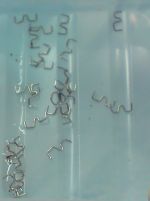Staple (Fastener)
 From Conservapedia
From Conservapedia .jpg)
A staple (from Old English stapol[1]) is a fastener which is usually made of metal. It is used to attach multiple objects, or bind one or more loose objects to a solid one. Most modern staples are thin strips or wires which are punched into or through material. However, other kinds exist, such as Dovetail Staples used in ancient construction.
Contents
- 1 History
- 2 Paper staples
- 3 Construction staples
- 4 Surgical staples
- 5 Other kinds
- 6 References
History[edit]
Since at least 1200 A.D., people have been trying to attach sheets of paper. The first known method involved applying melted wax and ribbon to attach the upper left corner of pages. In the 18th century, King Louis the XV, was provided with a stapler of sorts, which was made by hand. According to legend, the king's staples were forged from gold, encrusted with precious stones, and bore his Royal Court's insignia.[2]
For those who must live within lesser means, a more practical stapler was patented in 1866. However, this "paper fastener," created by the Novelty Manufacturing Company, could only hold one staple. Also, this device only punched the staple through the paper—it did not bend the legs.[2]
The next development was the invention of a stapler which did bend the legs. This was known as McGill's Patent Single Stroke Staple Press. In 1895, the stapler became much more common when the E.H. Hotchkiss Company of Norwalk, Connecticut, released their "No. 1 Paper Fastener." This offered all the features of modern staplers—they held multiple staples, and bent the legs as soon as they passed through the paper. The only remaining problem was that the staples were attached to a wire, from which it was difficult to separate them. Hotchkiss users needed to press down very hard on the plunger, so much so that users sometimes kept mallets handy.[2]
Attempting to improve this problem, a variety of other staplers where created from this point on. Even the famous Hotchkiss was changed in many different ways over time. Even a handheld variety was patented on December 4, 1934 (patent number 1983397) as the Hotchkiss #54.[3] Each had its strengths and weaknesses, but all were difficult to refill with staples. Jack Linksy resolved this last problem, several years after he founded the Parrot Speed Fastener Corporation. In 1937, his company released the Swingline Speed Stapler No. 3. This stapler could be loaded by simply laying a strip of staples into a track inside. This effective design has been changed very little since then.[2]
Interestingly, the Japanese name for an office stapler is ホチキス (or sometimes ホッチキス) which is directly translated to hochikisu, which is a direct product of the name "Hotchkiss."[4]
Paper staples[edit]

Paper staples are the most common kind of staple used today. This kind of staple (and most others) is made of metal and consists of a crown (the top), a pair of legs (the sides), and teeth at the bottom, which are the ends of the legs. These are loaded into a device which punctures the paper with the staple, and bends the legs either inward or outward.

Staples are also sometimes used to affix paper or paperboard to other surfaces. They are often used on bulletin boards, drywall, and even telephone poles. When used in this manner, staples are punched through the paper and into the holding surface, but the legs remain straight.
Construction staples[edit]
Ancient construction sometimes used dovetail staples to attach stone blocks to one another. These were created by carving out a grove in stone, then pouring molten metal into it. However, modern construction uses a much smaller variety, much like paper staples in form. Modern staples are bent metal fasteners which are usually placed using a staple gun or staple hammer (a.k.a. hammer tacker). They are often used to hold wires, so it is not uncommon for them to have an insulation coating or a plastic strip to help protect the wires.
Surgical staples[edit]

If a person's (or sometimes animal's) skin gets cut so that it separates, it becomes very difficult for the injury to heal. For this reason, the two sides are usually pressed against each one so that healing is expedited and scarring is reduced. This is sometimes done with one of several special threads or strings, which is used to sew the sides together. In other cases, especially after surgery, staples are used.
Other kinds[edit]
Other kinds of staples exist as well, such as those used in the past to repair pottery and china. Narrow staples are also sometimes used for creating wooden boxes. Many varieties exist for both the purposes mentioned and those which have not been referenced.
References[edit]
- ↑ http://www.etymonline.com/index.php?term=staple&allowed_in_frame=0
- ↑ 2.0 2.1 2.2 2.3 http://mentalfloss.com/article/22619/brief-history-staples
- ↑ http://antiqueoutings.com/hotchkiss-stapler-54
- ↑ http://nihongo.monash.edu/hotchkiss.html
Categories: [Office Equipment]
↧ Download as ZWI file | Last modified: 02/14/2023 02:07:38 | 20 views
☰ Source: https://www.conservapedia.com/Staple_(fastener) | License: CC BY-SA 3.0
 ZWI signed:
ZWI signed: KSF
KSF